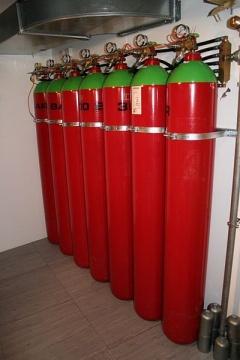Argon
| Infobox on Argon | |
|---|---|
| Example of Argon |  |
| Facts | |
| Origin | - |
| Stowage factor (in m3/t) | - |
| Humidity / moisture | - |
| Ventilation | - |
| Risk factors | - |
Argon
Description
Argon is a chemical element with symbol Ar and atomic number 18. It is in group 18 (noble gases) of the periodic table. Argon is the third most common gas in the Earth's atmosphere, at 0.93% (9,300 ppm), making it approximately 23.8 times more abundant than carbon dioxide (390 ppm). Nearly all of this argon is radiogenic argon-40 derived from the decay of potassium-40 in the Earth's crust. In the universe, argon-36 is by far the most common argon isotope, being the preferred argon isotope produced by stellar nucleosynthesis in supernovas.
The name "argon" is derived from the Greek word αργον meaning "lazy" or "the inactive one", a reference to the fact that the element undergoes almost no chemical reactions. The complete octet (eight electrons) in the outer atomic shell makes argon stable and resistant to bonding with other elements. Its triple point temperature of 83.8058 K is a defining fixed point in the International Temperature Scale of 1990.
Argon is produced industrially by the fractional distillation of liquid air.
Argon has approximately the same solubility in water as oxygen and is 2.5 times more soluble in water than nitrogen. Argon is colorless, odorless, and nontoxic as a solid, liquid, and gas. Argon is chemically inert under most conditions and forms no confirmed stable compounds at room temperature.
Although argon is a noble gas, it has been found to have the capability of forming some compounds.
Application
Argon is a colourless, non-inflammable gas used in the manufacture of electric and specialized light bulbs.
Argon is mostly used as an inert shielding gas in welding and other high-temperature industrial processes where ordinarily non-reactive substances become reactive; for example, an argon atmosphere is used in graphite electric furnaces to prevent the graphite from burning. Argon gas also has uses in incandescent and fluorescent lighting, and other types of gas discharge tubes. Argon makes a distinctive blue-green gas laser.
Argon is an asphyxiant in the poultry industry, either for mass culling following disease outbreaks, or as a means of slaughter more humane than the electric bath. Argon's relatively high density causes it to remain close to the ground during gassing. Its non-reactive nature makes it suitable in a food product, and since it replaces oxygen within the dead bird, argon also enhances shelf life.
Argon is sometimes used for extinguishing fires where damage to equipment is to be avoided.
Shipment / Storage
Argon is shipped compressed in steel cylinders. Leakage may occur through improperly secured stoppers.
Risk factors
Although argon is non-toxic, it does not satisfy the body's need for oxygen and is thus an asphyxiant. Argon is 25% more dense than air and is considered highly dangerous in closed areas. It is also difficult to detect because it is colorless, odorless, and tasteless. A 1994 incident in which a man was asphyxiated after entering an argon filled section of oil pipe under construction in Alaska highlights the dangers of argon tank leakage in confined spaces, and emphasizes the need for proper use, storage and handling.
Reference is made to the relevant IMO regulations on hazardous cargo.











